-Paneer hanging to drain, Crawford Market, Mumbai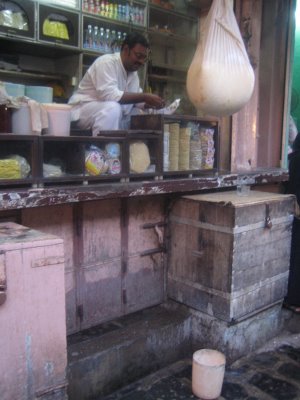 Paneer is India's cottage cheese made from heating milk with a little acid, usually lemon juice or vinegar to seperate the curd from the whey. Then the curd is hung to extract more whey, it is also sometimes pressed to make it more condensed and solid so it can be cut into cubes and used in savory dishes like saag paneer (spiced spinach w/ paneer). Paneer is one of the holy milk preparations of India used to make sweets to offer to the gods or to enjoy at festivals, or for sweets to be served simply with tea.
Paneer is India's cottage cheese made from heating milk with a little acid, usually lemon juice or vinegar to seperate the curd from the whey. Then the curd is hung to extract more whey, it is also sometimes pressed to make it more condensed and solid so it can be cut into cubes and used in savory dishes like saag paneer (spiced spinach w/ paneer). Paneer is one of the holy milk preparations of India used to make sweets to offer to the gods or to enjoy at festivals, or for sweets to be served simply with tea.
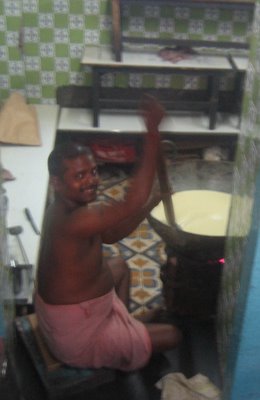 -Milk reducing over a wood fire to make Koya next to Mahalaksmi Temple, Mumbai
-Milk reducing over a wood fire to make Koya next to Mahalaksmi Temple, Mumbai
Tune: Calling All Cows by the Blues Rockers from the Excello Records vault
 Desi and friend contemplate some Italian cuisine at a tourist restaurant in Goa while a cow enters a puppet workshop in Rajasthanon, below.
Desi and friend contemplate some Italian cuisine at a tourist restaurant in Goa while a cow enters a puppet workshop in Rajasthanon, below.
.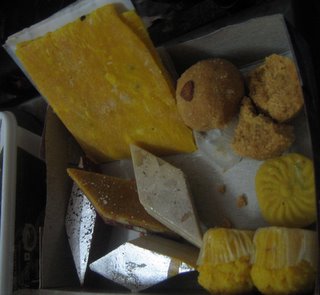

Sweets made from milk
-above, malai kheer (sweet milk simmered with saffron and cardamom) at Heeraz and Shubhra's wedding in Ajmer.
-left, barfi and other milk sweets from one of Mumbai's many sweet shops.
-Here is one of my versions of an Indian milk based dessert, "The Taj Mahal", Elephant heart plum kulfi is topped with a saffron Italian merengue bringing together the flavors of masala kulfi w/ the idea of baked Alaska 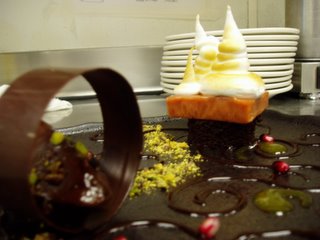


This is the "Mumbai Bazaar", gajar ka halwa wrapped in a crisp, sweet urad daal tuile (the stripes are from black daal and white daal, hulled and w/ it's black skin), topped w/ saffron foam, served w/ black urad daal gelato over cardamom- jaggery puffed rice (murmura) candy and a pandaan (screw pine) sauce.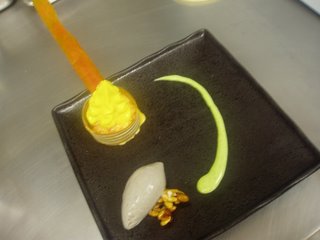
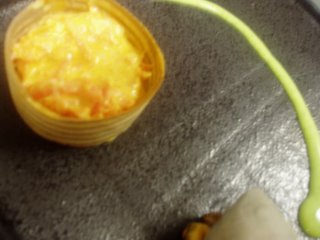
 Check out these desserts.
Check out these desserts.
Gulab Jamun, fried dough balls made from a mix of koya and paneer then saoked in a flavored syrup, usually rose, cardamom, and/or saffron Although the old school method of making gulab jamun is still popular, there are many premade mixes and maida (self rising flour) and milk powder is often substituted for the more labor intensive processes of traditional paneer and koya that require the care and patience appreciated by the slow food movement.
Although the old school method of making gulab jamun is still popular, there are many premade mixes and maida (self rising flour) and milk powder is often substituted for the more labor intensive processes of traditional paneer and koya that require the care and patience appreciated by the slow food movement.
There are many fried dough snacks served all around the globe. Gulab Jamun is unique in the fact that the dough is made with cheese. Some Italian pastries use fried dough and cheese, like cannoli. The Roman, rags to riches politico Marcus Cato has a recipe for milk dough fritters soaked in honey (called globi) which have a very close resemblence to Gulab Jamun in his manuel On Farming. Written in 170 B.C., On Farming is the first surviving work of latin prose and features the recipe in entry #79, halfway through the manuel: "Globi to be made thus: mix cheese and emmer.... ; make as many balls as you want. Put fat in a hot bronze pan: cook one or two at a time, turning them frequently with two sticks. When cooked remove them, coat in honey, roll in poppy-seeds, serve. "
I like how they used to roll the sweets in poppy seeds after soaking in homey. But, sadly this tradition has faded away and these poppy seed coated sweets are no longer popular. Roman globi have evolved into the Italian Sfingi and the Zeppele. They have many variations and although they are traditionally made from a ricotta cheese dough, some are made from choux paste or yeast doughs. Many are still soaked in a flavored sugar syrup like their cousins gulad jamun and their grandmother globi, but the flavor is usually citrus zest, cinnamon or vanilla. Although some are simply rolled in granulated sugar like a donut. San Guiseppe (St Joeseph's Day, March 19thy) is the day for zeppole in Italy, especially Naples, where friggitorie (fried food stalls) and pasticcerias (pastry shops) serve Zeppoles by the millions. 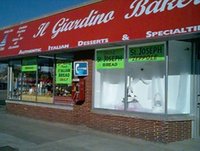
 Italian bakeries in Chicago start advertising in February.
Italian bakeries in Chicago start advertising in February.
-Il giardino on Harlem Ave in Chicago
If you happen to be in Paris on the Prarie picking up some Zeppeli for St. Joseph's Day, you should probably pick up a Chicago style hot dog anywhere you see a sign like this below: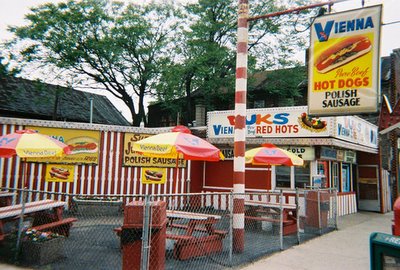 -just make sure you don't ask for ketchup on your hot dog
-just make sure you don't ask for ketchup on your hot dog
Tune:No More Hot Dogs by the wild man, outsider hillbilly punk, Hasil Adkins
Tune: I'm a Little Weenie by the Windy City legend with a Chitown figure, Dick "Two Ton" Baker ("The Music Maker of Chicago")
If you are in Chitown and you are really hungry and a dog won't cut the mustard, then head over to Maxwell St (actually S. Union Street, next to the Dan Ryan just off of Roosevelt Rd) and fork over $2.50 for a Maxwell Street Polish Sausage at Jim's Grill, home of the original Maxwell St Polish Sausage invented in 1910 by an immigrant from Yugoslavia in 1914. Up until the early 90's Jim's was in a historic pre-Chicago fire building on the corner of Halsted and Maxwell St. The maxwell Street market that flourished back in the day was the birthplaace of Chicago Blues and urban electric blues. Many African American's from Mississippi, Louisiana, and other southern states migrated to Chicago from rural areas to escape the world of Jim Crow and sharecropping to work in the steel mills and meat packing factories of Chicago. (I guess they never read Upton Sinclaire's The Jungle) They brought with them their rich culture of music and stories. Adapting to it's new environment the folk delta blues music plugged into the electricity of urban life. Muddy Waters, who once led a jug band in Mississippi and was well known for the stories that accompanied his acoustic guitar, had become famous in Chicago for combining the rich culture of the delta blues with the new sounds of the electric guitar. Muddy and countless other blues pioneers used to play as street musicians at Maxwell St. and in bar band in the area.  Muddy's pal Hound Dog Taylor, also from Mississippi, used to play electric slide guitar with a cheap amp cranked to distorted levels on a cheap guitar on Maxwell Street. His sound was so heavy that he makes these guys sound soft. Where did Hound Dog Taylor plug in? He used to have an extension cord that ran into Jim's Grill! He would plug in next to the kitchen sink. One Maxwell Street legend as told by Chicken Charlie, is that once the dishwasher at Jim's let the sink overflow while snacking on a Polish and the water dripped onto Hound Dog's guitar cord and gave him a mighty shock of a lifetime. This shock is said to be the inspiration behind Kitchen Sink Boogie. One of my favorite Hound Dog Taylor songs is 55th st Boogie. This is a real summertime scorcher. I loved this song when I first heard it as a kid when I lived right off of 55th street.
Muddy's pal Hound Dog Taylor, also from Mississippi, used to play electric slide guitar with a cheap amp cranked to distorted levels on a cheap guitar on Maxwell Street. His sound was so heavy that he makes these guys sound soft. Where did Hound Dog Taylor plug in? He used to have an extension cord that ran into Jim's Grill! He would plug in next to the kitchen sink. One Maxwell Street legend as told by Chicken Charlie, is that once the dishwasher at Jim's let the sink overflow while snacking on a Polish and the water dripped onto Hound Dog's guitar cord and gave him a mighty shock of a lifetime. This shock is said to be the inspiration behind Kitchen Sink Boogie. One of my favorite Hound Dog Taylor songs is 55th st Boogie. This is a real summertime scorcher. I loved this song when I first heard it as a kid when I lived right off of 55th street.
Tune: 55th Street Boogie by Hound Dog Taylor and the Houserockers
Tune: Kitchen Sink Boogie also by Hound Dog Taylor and the Houserockers
Tune: I'd Rather Drink Muddy Water by Chicago singer Billie McKenzie -Maxwell Street band 1968
-Maxwell Street band 1968 -Chicken Charlie, one of Maxwell Street's regular colorful characters
-Chicken Charlie, one of Maxwell Street's regular colorful characters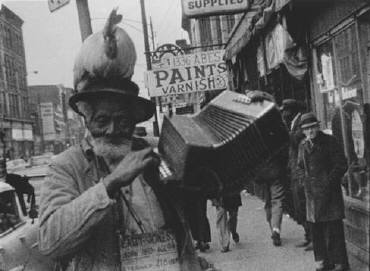
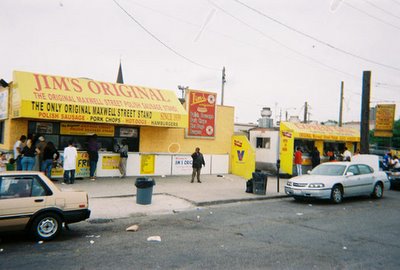 Some people prefer the Polish's at Express Grill, which was opened by a relative of the Jim's Grill family and also used to be on Maxwell St. Now they are right next to each other along the highway.
Some people prefer the Polish's at Express Grill, which was opened by a relative of the Jim's Grill family and also used to be on Maxwell St. Now they are right next to each other along the highway. Both of these places serve old school Maxwell St. Polish's just like Jim's did back in the roaring 20's with grilled onions and mustard.
Both of these places serve old school Maxwell St. Polish's just like Jim's did back in the roaring 20's with grilled onions and mustard. Only thing that has changed is the location. Sadly, the University of Illinois Chicago took over the area that once was home to Maxwell Street Market around 1994 in a deal with mayor Daley.
Only thing that has changed is the location. Sadly, the University of Illinois Chicago took over the area that once was home to Maxwell Street Market around 1994 in a deal with mayor Daley.
-Maxwell St circa 1963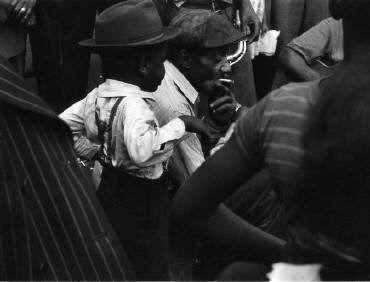 -Maxwell Street today
-Maxwell Street today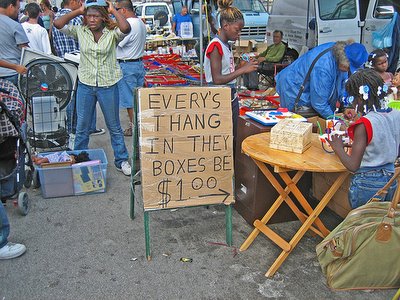

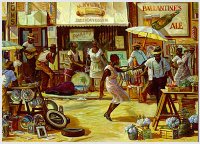

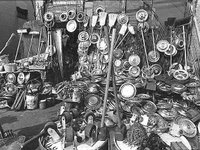
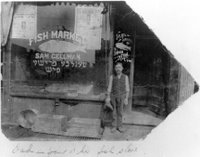 Maxwell Street neighborhood used to be called Jewtown, even by the blues musicians, because the market was founded in the mid 1870's by Eastern European Jews. Since then Maxwell Street has been a home and a meeting place for people from all over the world. The much smaller and compromised version of the market that survives today on the outskirts of the original location is a great place for authentic Mexican food, like zuchinni blossom quesadillas, octopus ceviche, and beef tongue tacos.
Maxwell Street neighborhood used to be called Jewtown, even by the blues musicians, because the market was founded in the mid 1870's by Eastern European Jews. Since then Maxwell Street has been a home and a meeting place for people from all over the world. The much smaller and compromised version of the market that survives today on the outskirts of the original location is a great place for authentic Mexican food, like zuchinni blossom quesadillas, octopus ceviche, and beef tongue tacos.
-This sign for a grocery store near Maxwell St. shows that there are shoppers from all cultures who can still find what they want in this uniquely diverse city If you are not up for a Maxwell Street Polish or a tongue taco, you can always find an Italian beef sandwich, downtown, northside, southsibe, westside, or the 'burbs.
If you are not up for a Maxwell Street Polish or a tongue taco, you can always find an Italian beef sandwich, downtown, northside, southsibe, westside, or the 'burbs.
Des enjoys a beef from Buona Beef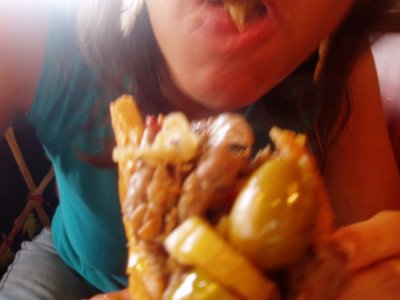 BuonaBeef is not the usual ma and pa kinda place I like to recommend, but it sure is goooood!
BuonaBeef is not the usual ma and pa kinda place I like to recommend, but it sure is goooood!
-Beef w/ giardinare to go
The best Pizza in the world is thin crust and is cut in squares, and the best place for real Chicago pie is the Spaghetti Bowl of Western Springs. This is not tourist deep dish, eat once every two months, spend $30 pizza. This is real Chitown pie. Eat it four to five times a week and still keep that great Chicago figure. Well, the bowl is leaving it's historical home at 808 Hillgrove. But it is keeping what counts. The ovens. Temporary home to some of the culinary arts greatest offerings to mankind, these ovens have seen enough cornmeal to fill the Grand Canyon. Leave em on overnight and the next day's pies are golden crisp love letters.
-here is the original Bowl next to its new home. But the old wise man that sits under the WS Watertower says, "You can take the ovens out of the historical landmark, but you can't take the love and flavor out of the pie."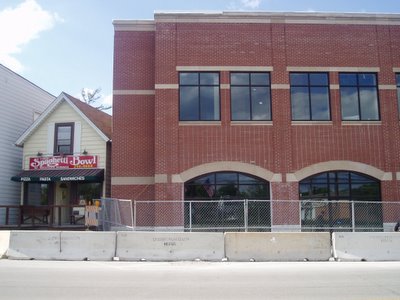 -Here I have an important meeting with the Bowl's top dog Timmy C discussing the importance of modern food trends, the integrity of traditional pizza making, and the future of Chicago's greatest pizzaria.
-Here I have an important meeting with the Bowl's top dog Timmy C discussing the importance of modern food trends, the integrity of traditional pizza making, and the future of Chicago's greatest pizzaria.
-The Bowl's Pizzailo's hard at work. Temperature? ...175 degrees F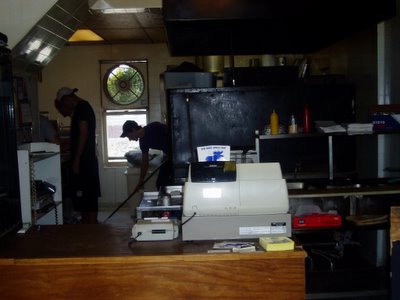

Friday, July 14, 2006
Say Cheese!
Subscribe to:
Post Comments (Atom)
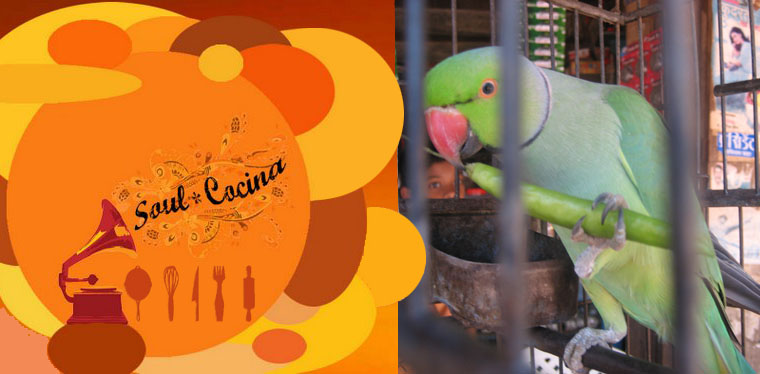
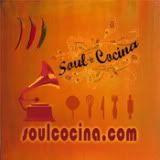




No comments:
Post a Comment